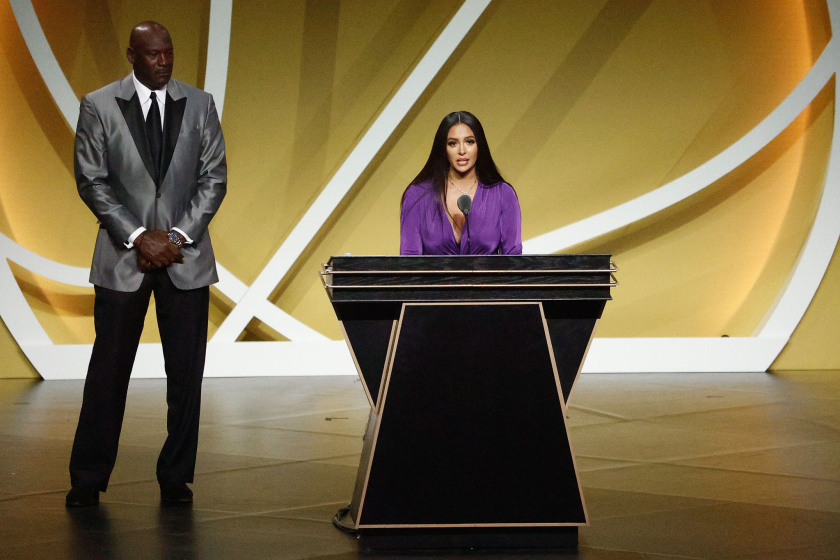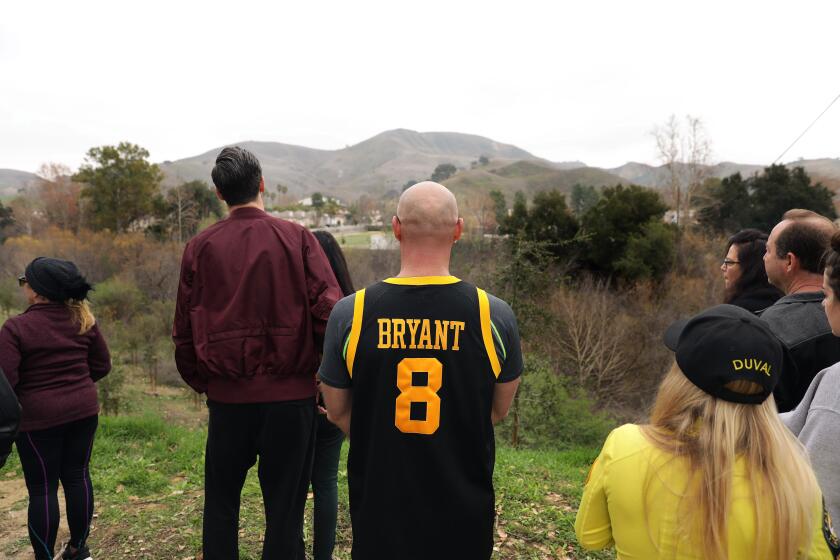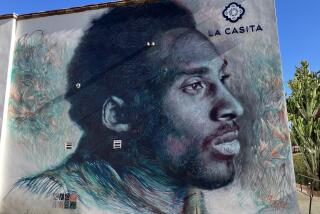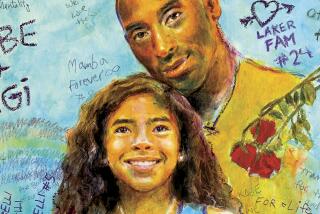Vanessa Bryant says sheriff’s deputies violated the dignity of her husband and daughter
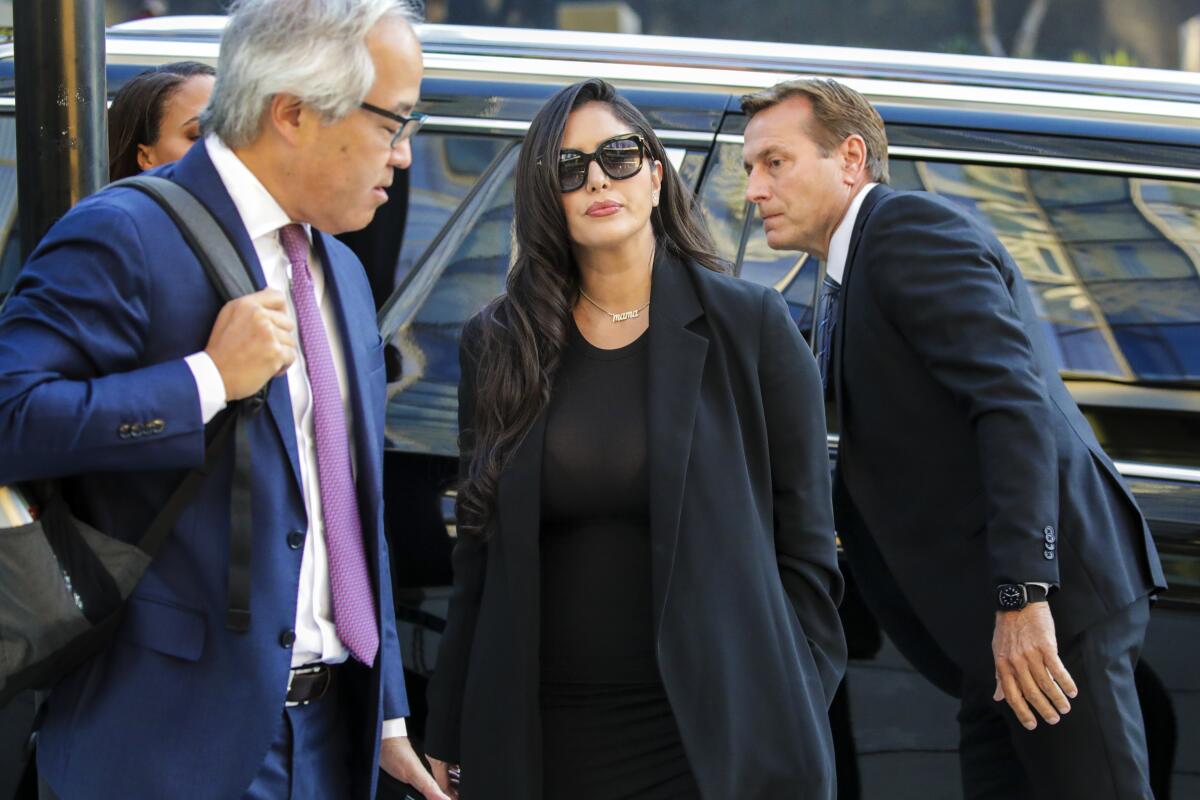
A few days after the 2020 memorial for Kobe Bryant, the basketball star’s widow, Vanessa, was at home watching TV with family when she learned that Los Angeles County sheriff’s deputies had shared gruesome photos of the helicopter crash that killed her husband and the couple’s 13-year-old daughter, Gianna.
“I bolted out of the house,” Vanessa Bryant testified Friday in federal court in Los Angeles. Once she found a spot where her other three daughters could not hear her, she said, “I broke down and cried, and I wanted to run down the block and just scream.”
Bryant, who repeatedly burst into tears on the witness stand, said she felt betrayed by deputies she had trusted to protect her family.
“I expected them to have more compassion — respect,” Bryant testified. “My husband and my daughter deserve dignity.”
Bryant’s appearance came on the eighth day of a trial in her federal lawsuit against L.A. County over graphic images of the crash scene that were taken and shared by sheriff’s deputies and firefighters. Chris Chester — whose wife, Sarah, and daughter, Payton, were killed in the crash — has also sued the county. He finished testifying just before Bryant took the stand.
Bryant and Chester have alleged that the photos that deputies and firefighters took and disseminated amounted to negligence and invasion of privacy. The helicopter slammed into a Calabasas hillside in dense fog on Jan. 26, 2020, killing Kobe and Gianna Bryant, the Chesters and five others on their way to a youth basketball game in Thousand Oaks. Lawyers for the county have argued that the photos did not spread widely and were not posted online.
Sheriff Alex Villanueva also took the stand Friday as a witness for the county. During his testimony, he tried to walk back public statements he made in the aftermath of the crash that only members of the National Transportation Safety Board, which investigates plane crashes, or the coroner’s office had legitimate reasons to take photos of the crash scene. Any other images would be inappropriate, he said.
Instead, Villanueva contended that one of the deputies who responded to the crash needed to take photos in order to document the scene. The sheriff’s reversal put him in line with one of the main claims lawyers for the county have put forth in the trial. They’ve said that deputies were doing their jobs when they took and shared photos.
Villanueva also backtracked on comments he’d made in 2020 interviews that “death books,” a sort of scrapbook that police officers keep of crime and accident scenes, are a problem in law enforcement. On the stand, he testified that there’s no record of a widespread problem in his department, again mimicking a position the county has taken in the lawsuit.
The high-profile trial began Wednesday, with Vanessa Bryant’s attorney describing the carnage from the helicopter crash that killed Kobe Bryant — and the photos sheriff’s deputies displayed of the crash.
Bryant’s testimony started with a look at the Newport Beach home life of the basketball legend and his family.
“He was this well-known and beloved icon to some people, and at home he was just Kobe; he was just Daddy,” Bryant told the jury. “He knew he did not rule the household.”
The couple had hoped to “travel the world” after his retirement from the Lakers, she told the jury.
The testimony turned intensely emotional as Bryant shared recollections from the day of the crash. She recalled racing to the Lost Hills Sheriff’s Station near the accident scene and learning from Villanueva that her husband and daughter had died.
He asked if there was anything he could do for her, and she urged him to secure the wreckage site.
“I’m concerned about paparazzi,” she recalled telling Villanueva. She said he assured her that authorities had established a “no-flight umbrella” over the scene.
A month later, on Feb. 27, 2020, The Times broke the story of the photos that deputies had taken and shared.
Bryant’s attorney, Luis Li, showed Bryant an email in which then-Capt. Jorge Valdez, a top aide to Villanueva who has since been promoted twice, lied to The Times just before it published its story about the photos, saying a reporter’s inquiry had forced law enforcement “to personally contact the family members and advise them of the details surrounding your allegations.”
L.A. Sheriff’s Department says it is looking into reports that deputies shared graphic images of the Kobe Bryant helicopter crash scene.
Bryant testified that, in fact, nobody from the Sheriff’s Department notified her of the allegations. Chester testified that he was not contacted either.
Bryant also said she has since lived in fear that the photos will surface someday on the internet and at times has panic attacks.
“I don’t want my children to ever come across them,” she testified. “I have three little girls.”
Bryant said her husband’s remains were recovered the day of the crash, but her daughter’s were removed from a ravine the next day, so whoever photographed her had to have removed the covering that had been placed upon her.
“They violated her, taking advantage of the fact that her daddy couldn’t protect her,” she testified. “He was at the morgue.”
Bryant said the clothing that Kobe and Gianna were wearing during the crash, which was returned to her, was burned, giving her an idea of what the photos of their remains might have looked like.
“I don’t think anybody should ever see their family members in that way,” she said.
On cross-examination, a lawyer for the county questioned Bryant about business endeavors and travel she’s done since the crash in an apparent attempt to cast doubt on the severity of the emotional distress Bryant says she has suffered.
The county attorney also pressed Bryant on her decision to bring the lawsuit in the first place, saying that doing so has brought to light details about the condition of the victims’ bodies that otherwise would have remained more private.
“I am willing to go to hell and back to get justice for my husband and my daughter,” Bryant replied.
Jurors spent the last week and a half hearing from sheriff’s deputies, firefighters and their supervisors about what they did and why. Several of them gave testimony that was inconsistent with their earlier statements. One fire captain who took photos claimed on the stand that he didn’t remember being at the crash site at all. The identity of at least one firefighter who received the photos remains unknown.
Their testimony opened the door for Chester and Bryant to hammer on a central claim in their cases: that although photos of the crash have not been posted to the internet, the lack of clarity over who received the photos and whether they have been deleted has fed their worry that one day they could surface online, compounding their pain and suffering.
The shifting stories and sudden amnesia were among several inconsistencies and contradictions that lawyers for Vanessa Bryant focused on in the trial’s fourth day.
“The inconsistencies, the level of uncertainty,” Chester testified Thursday. “It’s very clear to me that we have no idea the extent of pictures.”
He added: “I’m fearful all the time, every day.”
Lawyers for Chester and Bryant have argued that because the county didn’t take proper steps to preserve and examine the phones of all the employees who shared the grim pictures, it’s impossible to tell how far they spread. And that means they could show up online at any moment.
What’s certain is that one sheriff’s deputy flashed the photos on his phone screen to a bartender in Norwalk.
Security footage played for jurors showed the bartender then hop from table to table, using hand gestures to describe to patrons what he’d just seen. One of them, Ralph Mendez, testified that he was so disgusted that he filed a complaint to the Sheriff’s Department.
Villanueva testified that when he learned of the complaint, he offered amnesty to the deputies if they came clean and deleted the photos. In the month after the deputies cooperated with his order, he said, his investigators were still fanning out and chasing down leads in the case.
But internal sheriff’s records show that a formal investigation wasn’t initiated until the day after The Times published its investigation — about a month later. And no testimony during the trial indicated the investigation was ongoing before that.
In fact, Valdez testified that after he received security footage from the Norwalk bar after Mendez filed his complaint, he watched a snippet of it before locking away the USB drive containing it in a cabinet in his office that only he could access. He said he did not retrieve it until after The Times investigation was published.
Firefighters also saw the images at an awards gala at the Hilton Hotel in Universal City. And another sheriff’s deputy testified that he sent the images to his friend, also a deputy, while the pair played the video game “Call of Duty.”
When Chester learned of the photos, the empty sadness he said he felt shifted to anger and rage.
“In my mind the damage has been done,” Chester testified, saying that even though the images, which included close-ups of the carnage, have not been posted online, they were paraded around in public.
Some first responders, while sitting on the witness stand, acknowledged the pain they brought to the families and apologized to Bryant and Chester for the first time.
“I took it too far,” testified Joey Cruz, the deputy who showed the photos to a bartender.
Under cross-examination, Villanueva said he would have expected his internal investigators to have scoured through deputies’ iCloud accounts, tablets and social media accounts as part of their probe. But when lawyers questioned whether they did those things, Villanueva said his investigators did a thorough job since the photos haven’t surfaced.
“I believe they were all deleted,” he testified, adding that after 2½ years with no photos, “I’m pretty sure that’s accurate.”
When pressed further, he said: “God knows — that’s about it.”
More to Read
Sign up for Essential California
The most important California stories and recommendations in your inbox every morning.
You may occasionally receive promotional content from the Los Angeles Times.
